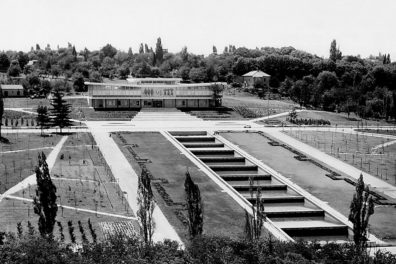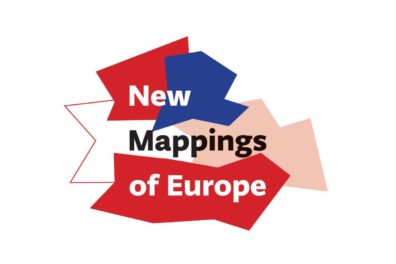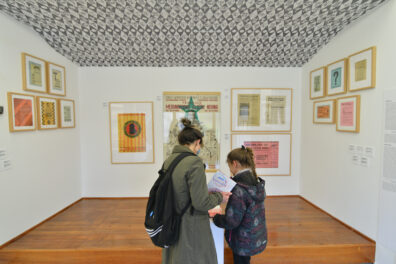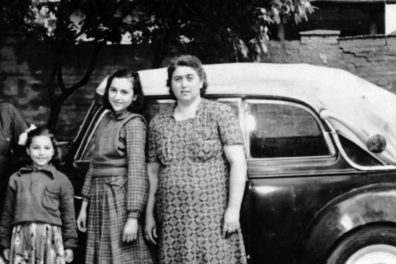Online discussion about Mitja Velikonja’s book “Political Graffiti”
An online discussion will be held about the book “Political Graffiti”, published by the Biblioteka XX vek, written by Mitja Velikonja, a regular professor and researcher at the Faculty of Social Sciences at the University of Ljubljana. It is a publication that problematizes graffiti and street art, putting, through case studies, the focus on post-socialist political graffiti (and street art interventions) in the Balkans and Central Europe.
Besides the author, about the book itself will speak Ivan Čolović, political anthropologist, publisher and writer, Igor Štiks, writer and political theorist, and Ljiljana Radošević, art historian and cultural manager, but also about numerous socially relevant topics that it raises. The discussion will be moderated by Marija Đorgović and Simona Ognjanović, curators of the Museum of Yugoslavia.
What do political graffiti and street art say about the societies and communities in which they are created; what do the walls tell us and how can we learn to read them and understand them better? What is their activist and emancipatory potential? To what extent can they be interpreted as the conquest of personal and civil freedom, and to what extent do they serve to strengthen the dominant social narrative? Does the institutionalization of graffiti and street art strengthen the democracy of these artistic and social practices or does it lead to their pacification and depoliticization? These are some of the issues that the participants in the conversation will try to problematize using “Political Graffiti” as a starting point.
As they explain from the Biblioteka XX vek, with the study “Political Graffiti: Examples from the Post-socialist States of the Balkans and Central Europe” as its full name reads, Mitja Velikonja lays the foundations of a new interdisciplinary science – graffitiology. The book won the award for the best scientific achievement of the University of Ljubljana for 2020. In the first part, the author introduces readers to the theoretical and methodological problems of studying graffiti and street art, while in the second part he analyzes the mentioned examples. These case studies are dedicated to graffiti with nationalist and extreme right-wing messages of hatred, graffiti of football fans and graffiti related to Yugoslavia, disputed heroes (Gavrilo Princip and Rudolf Meister), Mount Triglav (as a political symbol), and migrants.
The program will be available on the Museum’s YouTube channel:
The conversation is part of the program “Talks about Yugoslavia: Introduction to (post) Yugoslav Studies”, launched by the Museum of Yugoslavia in 2014 with the idea of analyzing various Yugoslav phenomena through a transdisciplinary cultural approach.
More about the author and participants:
Mitja Velikonja (1965) is a professor for Cultural Studies and head of Center for Cultural and Religious Studies at University of Ljubljana, Slovenia. The main areas of his research are contemporary Central European and Balkan political ideologies, subcultures, collective memory and post-socialist nostalgia. He was a visiting professor at the Jagiellonian University in Krakow (2002 and 2003), at Columbia University in New York (2009 and 2014), at the University of Rijeka (2015) and at Yale University in New Haven (2020). Main areas of his research include Central-European and Balkan political ideologies, subcultures and graffiti culture, collective memory and post-socialist nostalgia. He was a full-time visiting professor at Jagiellonian University in Krakow (2002 and 2003), at Columbia University in New York (2009 and 2014), at University of Rijeka (2015), at New York Institute in St. Petersburg (2015 and 2016), Fulbright visiting researcher at Rosemont College in Philadelphia (2004/2005) and research fellow at The Netherlands Institute of Advanced Studies in Wassenaar (2012).
With Dino Abrazović, Velikonja is the co-editor of the book “Post-Yugoslavia – New Cultural and Political Perspectives” (Palgrave; 2014). Prior to this book, translations of his monographs “Eurosis – A Critique of the New Eurocentrism” (2007) and “Titostalgia – A Study of Nostalgia for Josip Broz” (2010), as well as the book “Celestial Yugoslavia: Interaction of Political Mythologies and Popular Culture,” which he wrote together with Vjekoslav Perica were published in the Biblioteka XX vek.
Ivan Čolović (Belgrade, 1938) is a political anthropologist, publisher and writer. He has published about twenty books, and in recent years: “Death on Kosovo plain: A history of the Kosovo myth”, “Pictures and Images”, “In the Order They Appeared”, “Virus in the Text”, “Essays on Political Anthropology 4.” Some of his books have been translated into English, French, Greek, Italian, Macedonian, German, Slovenian and Polish.
Čolović is the founder and editor (1971), and since 1989 he has been the publisher of the book series Biblioteka XX vek. He received several awards, including the Herder Award (2000), the Order of the Knight of the Legion of Honor (2001), the title of Honorary Doctor of the University of Warsaw (2010) and the Mirko Kovač, Award for the “Death on Kosovo Plain: A History of the Kosovo Myth”, 2017 .
Igor Štiks (Sarajevo, 1977) Dr. Igor Štiks earned his PhD at the Institut d’Études Politiques de Paris and Northwestern University and later worked and taught at the University of Edinburgh and the Faculty of Media and Communications in Belgrade. He is the author of Nations and Citizens in Yugoslavia and the Post-Yugoslav States: One Hundred Years of Citizenship (Bloomsbury, 2015). Together with Jo Shaw he edited the collections Citizenship after Yugoslavia (Routledge, 2013) and Citizenship Rights (Ashgate, 2013), and, with Srećko Horvat, Welcome to the Desert of Post-Socialism: Radical Politics after Yugoslavia (Verso, 2015). He is also the author of two novels, A Castle in Romagna and The Judgment of Richard Richter (originally published as Elijah’s Chair), which have won numerous awards and have been translated into 15 languages. He was honored with the prestigious French distinction Chevalier des arts et des lettres for his literary and intellectual achievements.
Ljiljana Radošević is an art historian and cultural manager from Belgrade, currently finishing her Ph.D. studies about street art at the University of Jyväskylä, Finland.
The title of her Ph.D. thesis is “Understanding Street Art”. This title was not chosen lightly, because she has been interested in graffiti and street art since she started her university studies. They have been her focus of interest throughout most of her professional life. In 2000 she started following Belgrade graffiti artists on a regular basis and that was it, she was hooked. She did her MA Art History thesis about Belgrade graffiti and has continued to follow the scene ever since. She has also organized several exhibitions, given many lectures and co-organized the graffiti project “New Way, New Life” for BELEF in 2003.
Graphic forms of expression in art and popular culture underline all of her interests in Art History and she went back to her first love – comics – during the course of her second MA in Cultural Management. This also resulted in her winning an internship at the most prestigious comic festival in Europe – FIBD Angoulême.
After several research positions unrelated to street art and graffiti, she returned to street art in her doctoral thesis in 2009. She did more than 50 interviews with graffiti and street artists, gallerists and researchers in Barcelona, London, Berlin, Paris and Stockholm. In addition to her thesis, she has published about a dozen academic articles about graffiti, street art and comics.
And now, after all this time she thought it was time to put the spotlight on the Belgrade scene again and dedicate proper academic attention to the new and exciting things happening on its streets.
http://www.mustekala.info/node/35776
An online discussion will be held about the book “Political Graffiti”, published by the Biblioteka XX vek, written by Mitja Velikonja, a regular professor and researcher at the Faculty of Social Sciences at the University of Ljubljana. It is a publication that problematizes graffiti and street art, putting, through case studies, the focus on post-socialist political graffiti (and street art interventions) in the Balkans and Central Europe.
Besides the author, about the book itself will speak Ivan Čolović, political anthropologist, publisher and writer, Igor Štiks, writer and political theorist, and Ljiljana Radošević, art historian and cultural manager, but also about numerous socially relevant topics that it raises. The discussion will be moderated by Marija Đorgović and Simona Ognjanović, curators of the Museum of Yugoslavia.
What do political graffiti and street art say about the societies and communities in which they are created; what do the walls tell us and how can we learn to read them and understand them better? What is their activist and emancipatory potential? To what extent can they be interpreted as the conquest of personal and civil freedom, and to what extent do they serve to strengthen the dominant social narrative? Does the institutionalization of graffiti and street art strengthen the democracy of these artistic and social practices or does it lead to their pacification and depoliticization? These are some of the issues that the participants in the conversation will try to problematize using “Political Graffiti” as a starting point.
As they explain from the Biblioteka XX vek, with the study “Political Graffiti: Examples from the Post-socialist States of the Balkans and Central Europe” as its full name reads, Mitja Velikonja lays the foundations of a new interdisciplinary science – graffitiology. The book won the award for the best scientific achievement of the University of Ljubljana for 2020. In the first part, the author introduces readers to the theoretical and methodological problems of studying graffiti and street art, while in the second part he analyzes the mentioned examples. These case studies are dedicated to graffiti with nationalist and extreme right-wing messages of hatred, graffiti of football fans and graffiti related to Yugoslavia, disputed heroes (Gavrilo Princip and Rudolf Meister), Mount Triglav (as a political symbol), and migrants.
The program will be available on the Museum’s YouTube channel:
The conversation is part of the program “Talks about Yugoslavia: Introduction to (post) Yugoslav Studies”, launched by the Museum of Yugoslavia in 2014 with the idea of analyzing various Yugoslav phenomena through a transdisciplinary cultural approach.
More about the author and participants:
Mitja Velikonja (1965) is a professor for Cultural Studies and head of Center for Cultural and Religious Studies at University of Ljubljana, Slovenia. The main areas of his research are contemporary Central European and Balkan political ideologies, subcultures, collective memory and post-socialist nostalgia. He was a visiting professor at the Jagiellonian University in Krakow (2002 and 2003), at Columbia University in New York (2009 and 2014), at the University of Rijeka (2015) and at Yale University in New Haven (2020). Main areas of his research include Central-European and Balkan political ideologies, subcultures and graffiti culture, collective memory and post-socialist nostalgia. He was a full-time visiting professor at Jagiellonian University in Krakow (2002 and 2003), at Columbia University in New York (2009 and 2014), at University of Rijeka (2015), at New York Institute in St. Petersburg (2015 and 2016), Fulbright visiting researcher at Rosemont College in Philadelphia (2004/2005) and research fellow at The Netherlands Institute of Advanced Studies in Wassenaar (2012).
With Dino Abrazović, Velikonja is the co-editor of the book “Post-Yugoslavia – New Cultural and Political Perspectives” (Palgrave; 2014). Prior to this book, translations of his monographs “Eurosis – A Critique of the New Eurocentrism” (2007) and “Titostalgia – A Study of Nostalgia for Josip Broz” (2010), as well as the book “Celestial Yugoslavia: Interaction of Political Mythologies and Popular Culture,” which he wrote together with Vjekoslav Perica were published in the Biblioteka XX vek.
Ivan Čolović (Belgrade, 1938) is a political anthropologist, publisher and writer. He has published about twenty books, and in recent years: “Death on Kosovo plain: A history of the Kosovo myth”, “Pictures and Images”, “In the Order They Appeared”, “Virus in the Text”, “Essays on Political Anthropology 4.” Some of his books have been translated into English, French, Greek, Italian, Macedonian, German, Slovenian and Polish.
Čolović is the founder and editor (1971), and since 1989 he has been the publisher of the book series Biblioteka XX vek. He received several awards, including the Herder Award (2000), the Order of the Knight of the Legion of Honor (2001), the title of Honorary Doctor of the University of Warsaw (2010) and the Mirko Kovač, Award for the “Death on Kosovo Plain: A History of the Kosovo Myth”, 2017 .
Igor Štiks (Sarajevo, 1977) Dr. Igor Štiks earned his PhD at the Institut d’Études Politiques de Paris and Northwestern University and later worked and taught at the University of Edinburgh and the Faculty of Media and Communications in Belgrade. He is the author of Nations and Citizens in Yugoslavia and the Post-Yugoslav States: One Hundred Years of Citizenship (Bloomsbury, 2015). Together with Jo Shaw he edited the collections Citizenship after Yugoslavia (Routledge, 2013) and Citizenship Rights (Ashgate, 2013), and, with Srećko Horvat, Welcome to the Desert of Post-Socialism: Radical Politics after Yugoslavia (Verso, 2015). He is also the author of two novels, A Castle in Romagna and The Judgment of Richard Richter (originally published as Elijah’s Chair), which have won numerous awards and have been translated into 15 languages. He was honored with the prestigious French distinction Chevalier des arts et des lettres for his literary and intellectual achievements.
Ljiljana Radošević is an art historian and cultural manager from Belgrade, currently finishing her Ph.D. studies about street art at the University of Jyväskylä, Finland.
The title of her Ph.D. thesis is “Understanding Street Art”. This title was not chosen lightly, because she has been interested in graffiti and street art since she started her university studies. They have been her focus of interest throughout most of her professional life. In 2000 she started following Belgrade graffiti artists on a regular basis and that was it. She did her MA Art History thesis about Belgrade graffiti and has continued to follow the scene ever since. She has also organized several exhibitions, given many lectures and co-organized the graffiti project “New Way, New Life” for BELEF in 2003.
Graphic forms of expression in art and popular culture underline all of her interests in Art History and she went back to her first love – comics – during the course of her second MA in Cultural Management. This also resulted in her winning an internship at the most prestigious comic festival in Europe – FIBD Angoulême.
After several research positions unrelated to street art and graffiti, she returned to street art in her doctoral thesis in 2009. She did more than 50 interviews with graffiti and street artists, gallerists and researchers in Barcelona, London, Berlin, Paris and Stockholm. In addition to her thesis, she has published about a dozen academic articles about graffiti, street art and comics.
And now, after all this time she thought it was time to put the spotlight on the Belgrade scene again and dedicate proper academic attention to the new and exciting things happening on its streets.
http://www.mustekala.info/node/35776
- Day: 19.01-19.01.2021
- Time: 19:00

The Origins: The Background for Understanding the Museum of Yugoslavia
Creation of a European type of museum was affected by a number of practices and concepts of collecting, storing and usage of items.

New Mappings of Europe

Museum Laboratory
Starting from the Museum collection as the main source for researching social phenomena and historical moments important for understanding the experience of life in Yugoslavia, the exhibition examines the Yugoslav heritage and the institution of the Museum

